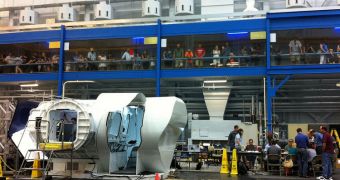Over the next 10 days, astronauts at the NASA Johnson Space Center (JSC), in Houston, Texas, will be testing out the new Space Exploration Vehicles (SEV) prototypes the agency created, as part of the latest iteration of the Research and Technology Studies (RATS) program.
These iterations have been going on yearly since 1998. Usually, they happen at some remote desert locations, where robots that may one day explore other worlds are put through their paces. This year, the event took place at the JSC because some of the needed equipment could not be moved.
What this year's iteration of RATS seeks to accomplish is conduct a mock mission to a near-Earth asteroid. This will enable the agency to test some of the new technologies it prepared specifically for this purpose, Space reports.
The mission currently being simulated targets asteroid Itokawa, which was visited by the Hayabusa sample-return spacecraft, launched by the Japan Aerospace Exploration Agency (JAXA), in 2003.
Locked inside the SEV for 10 days, the astronauts will always see a giant display showing the asteroid, moving in the same patterns as it would in real-life. The data required in order to model its motions was provided by JAXA from its mission, which returned samples back to Earth in 2010.
“This extremely realistic simulation allows us to fly around, approach, and anchor to the asteroid, all while monitoring our flight controls, propellant usage and many other factors,” planetary geologist and RATS crew member, Trevor Graff, wrote in a NASA blog post yesterday, August 21.
“Once we approach or anchor to the asteroid, one or more of us will perform a simulated spacewalk, also known as an EVA (Extra-Vehicular Activity),” he added, saying that the simulated space rock “looks and moves just like the real thing.”
In addition to the technical aspects of the simulation, this year's RATS event will also seek to understand how astronauts of the future will live inside the SEV. Since any spaceflight to an asteroid would take at least several months, this is very important.
“Once we were done with our flying tasks, we settled in for our evening tasks. That involved making a freeze dried dinner, setting up our cycle and exercising, and filling out a bunch of data sheets,” crew member and United Space Alliance engineer, David Coan, explained in another blog post.
“Exercising in the confined quarters was challenging, and we mostly stuck with using the cycle. We finished the night by configuring our bunks for sleeping, and shutting things down for the night,” he concluded.

 14 DAY TRIAL //
14 DAY TRIAL //